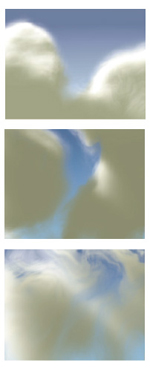
3D simulation of clouds animated and rendered interactively. From Interacting with Smoke and Fire in Real Time by Jos Stam.
Grading
There will be no exams for this course. Course grades will be based on 4 individual projects and 1 group project (see project expectations below) with the following grade break down.- Individual projects (4 @ 15%)
- In class demonstration and presentation
- Write up and code
- Project impact
- Includes vision, approach, uniqueness, successful implementation, relevance
- Group projects (40%) (Grades for group projects will consist of two components,
a grade for the entire project and an individual contributor grade.)
- Proposal
- Progress report
- In class demonstration and presentation
- Write up and code
- Project impact
- Includes vision, approach, uniqueness, successful implementation, relevance
Late Policy
- Oral presentations must be made on the scheduled day to receive a grade. Exceptions will only be made under dire circumstances (and may require a note from a proper authority)
- Project write-ups and code will be given full credit if handed in on or before the due date, ¾ credit if handed in after the due date but within one week of the due date and ½ credit if handed in more than one week after the due date but before the end of the reading period (May 4, 2006).
Collaboration
DoAsk questions of the professor and TAs Talk to other students about ideas and approaches Get ideas from your text, other books, on-line resources BUT... Reference ideas that you use in your assignments. For example
- From Foley, van Dam, Feiner, and Hughes, Computer Graphics Principals and Practice, Second Edition in C, Addison-Wesley, 1997, pp. 75
- From Rademacher, Ray Tracing: Graphics for the Masses, http://www.cs.unc.edu/~rademach/xroads-RT/RTarticle.html
Do NotUse ideas or code from other sources without referencing them